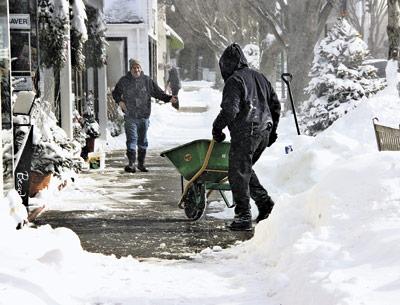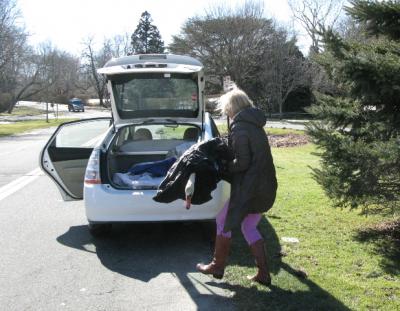A Winter to Remember
A Winter to Remember

Now that it’s March, it may be safe to say it without jinxing ourselves into another dozen snowstorms: What a long, strange winter it’s been.
All most of us will remember is snow and frigid temperatures, ice, constant shoveling, and days upon days, it seemed, of being housebound.
In fact, this winter has not, overall, been record-breaking, but it certainly has been trying, and its impact is still being reckoned.
By Feb. 18, according to The International Business Times, the metropolitan area had faced down 14 snowstorms and the seasonal snowfall in Manhattan’s Central Park stood at 56.6 inches. The all-time record for winter snowfall at the park, 75.6 inches, was set in 1995-96.
According to records from the United States Cooperative weather station in Bridgehampton, there was no measurable snowfall here in December. In January, however, 20 inches fell, and in February, 18.5. January’s total far surpassed last January’s, almost 5 inches, but the totals for February, last year and this, were within an inch of each other. A bit more snow fell last year.
Temperatures, according to the weather service, were all over the place, though record lows and cold days stand out, at least in our memories. In December, it was 16 degrees on the coldest day and a balmy 61 on the warmest. January temperatures ranged from 5 below zero to 55 above. A similar spread occurred last month.
And so it went. Over nine inches of snow on Jan. 22, the most recorded in one day at the weather service site in Islip since 2000. A 52-degree day in early February. Back down to 9 degrees on Feb. 11. On Friday, 24 degrees, then half that on Saturday.
With much of the country in a deep freeze, spiking demand for heating oil and gas, there was no similar fluctuation in the price for homeowners trying to stay warm — it just went up. According to the New York State Energy Research Development Authority, the average price on Long Island for propane, which was $3.12 a gallon at the beginning of March 2013, rose to $3.79 a gallon by the end of December. By Feb. 24, the per-gallon cost was $4.14, a more than 32 percent increase from the same time last year.
According to the U.S. Energy Information Administration, propane prices are influenced by several factors, in cluding supply and demand, and colder-than-normal weather puts the pressure on, raising the cost. Home heating oil prices rose by a much smaller margin between last March and the end of last month, beginning at $4.27 a gallon and ending at $4.45, NYSERDA’s website reports.
Outdoor conditions made walking difficult for even the most able-bodied, although Rob Balnis of East End Physical Therapy in East Hampton said last week that his practice had not seen much of an uptick in patients with injuries caused by falling on ice or in snow.
“Normally, we do,” he said. He theorized that with the weather so bad, more people stayed home rather than venture out into treacherous conditions. “In a sense, it’s a safe thing,” he said of the incessant storms.
That may be true. Marcia Kenny, director of marketing and public affairs at Southampton Hospital, said the emergency room had seen “quite a few sprains and falls” over the winter, but that no one had been treated for other weather-associated issues such as frostbite or hypothermia. “I guess people have been cautious,” Ms. Kenny said. “Conditions being what they are, I think people have just stayed home.”
The hospital does not keep records that cross-reference injuries and the weather, she said, so it would be hard to say whether there were more ice-and-snow-related injuries this year than in other winters.
Very cold days meant that schoolchildren were sometimes unable to get out into the fresh air and run around at recess. “Children need exercise and fresh air,” Beth Doyle, principal of John M. Marshall Elementary School, said in an email last week. “We take every opportunity to have outdoor recess. Even if the ground is wet, we have a modified recess on the blacktop. It helps with focus in the afternoon, especially for the little ones in kindergarten and first grade.” But on the worst days, recess was indoors.
Because snow day closures and delayed start times resulted in the loss of three full days and almost eight hours as of last week, “our number-one concern is the loss of instructional time,” Ms. Doyle said.
The cost of the winter, in tax dollars, was a little more than Stephen Lynch, the East Hampton Town Highway Superintendent, budgeted for, but he said the department could cover the increase. The budget contained $25,000 for snow removal costs; as of Tuesday, the costs had reached $49,355. Overtime for workers dealing with snow, for which Mr. Lynch had budgeted $28,000, has reached $49,000.
Contractors trying to make headway on construction projects have had a hard time of it this winter, too.
“The key word is ‘nightmare,’ ” said Marcus Kouffman, head of construction at MKL Construction in East Hampton. The good thing is, business has really picked up, he said, calling this one of the “busiest winters in the last four or five years, if not our busiest year ever.”
The cold and snow, Mr. Kouffman said, brought the shutdown of concrete plants (temperatures too low to pour concrete) and problems, should the thermometer happen to cooperate, in gaining access to sites due to piled-up snow. In addition, it was often difficult for the trade parade, workers who live elsewhere and commute here, to get to job sites.
“Every day I lost a day, the subcontractors lost a day” and got behind on their work lists, Mr. Kouffman said. “This winter, particularly, we never had a real melt. Everyone’s geared up and ready to go, and scheduled — and you can’t.” One suggestion that came up — a serious consideration, he said — was to tent an entire property to let construction proceed.
When there is a break in the weather, the builder said, “it’s scramble time.” He said he needs a good 7 to 10 working days “of no interference” to catch up.
“I have three weather apps on my phone,” Mr. Kouffman said. “I check them against each other every day.” With high season not too far off, he said, “this is pushing the gray zone.”
Those in the plumbing and heating trade have been much in demand. The unremitting freeze has taxed heating systems. “More issues come to light because they’re working so hard,” said John Grant, the owner of Grant Heating and Cooling in East Hampton. Some people have called in for repairs thinking their furnace or boiler has gone down, he said, when in fact they have just run out of fuel. It was gobbled up faster than normal in the bitter cold.
Mr. Grant said frigid temperatures increase “the urgency of any type of heat call, because there’s more danger of a house freezing.” That has meant some late nights for his technicians, who have had to contend with their own problems in getting to a job, especially during storms.
“It can be difficult to get out, but you have to,” Mr. Grant said. “We’ve had vans stuck, and difficulty getting into driveways.”
The tough winter might have a silver lining for Mr. Grant and those in similar businesses, however, as “people kind of see the weaknesses in their systems,” he said, and might now decide to have a more efficient and money-saving system installed.
Even though it’s still cold out, Mr. Grant is already in “transition time,” planning ahead for the coming season. “Even with snow on the ground, we have to think about air-conditioning,” he said.
One might think the conditions would have stemmed the tide of house-shoppers or delayed decisions about summer rentals. “It’s almost an annual event that bad weather forecast on Wednesday or Thursday kills our weekend,” said Tom MacNiven, a broker with Douglas Elliman in East Hampton.
But, he said, “people looking to buy or rent have really been troopers,” willing, if need be, to trek down long unplowed driveways in snow boots to see a property. “Things are selling; things are renting,” Mr. MacNiven said. “I really think people have said, ‘We’re done with this. Summer has not been canceled.’ ”







